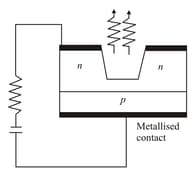Intrinsic and Extrinsic Semiconductor
Intrinsic and Extrinsic Semiconductor: Overview
This topic discusses the intrinsic and extrinsic semiconductors and their types in brief. It explains the concentration of free electrons and holes in both the semiconductors and the difference between the two semiconductors.
Important Questions on Intrinsic and Extrinsic Semiconductor
The diagram below is showing:

The resistivity of semiconductor varies with temperature. Which of the following curve represents the correct behaviour?
An intrinsic semiconductor has atoms and the carrier concentration . If it is doped by a pentavalent impurity in the ratio , then calculate number density of holes as charge carriers.
The resistivity of a semiconductor at room temperature is in between
In a -type semiconductor, which of the following statement is true?
An N-type silicon sample of width thickness and length carries a current of when the voltage is applied across the length of the sample. What is the current density? If the free electron density is , then find how much time it takes for the electrons to travel the full length of the sample.
For a pure Si crystal has atom $\mathrm{m}^{-3}$. It is doped by PPM concentration of pentavalent As. Calculate the number of electron & holes.
(Given that )
When an intrinsic semiconductor such as is doped with a small amount of a trivalent impurity like boron
The intrinsic carrier concentration in silicon at is known to be . A sample of silicon is doped with arsenic (a group element). Under these circumstances the concentrations of electrons and holes in the sample are
Intrinsic carrier concentration of a silicon sample at is After doping, the number of majority carriers is The minority carrier density is
The base region of a silicon n-p-n transistor is obtained by doping with either
What is the effect of temperature on an intrinsic semiconductor?
What are minority current carriers in Extrinsic semiconductor.
Which of the following energy band diagram shows the N-type semiconductor
In -type semiconductor, Silicon is doped with
The charge carriers in an electrolyte are
What will happen if we increase temperature in an intrinsic semiconductor ?
In an intrinsic semiconductor, Its carrier density increases with _____.
In an intrinsic semiconductor, Its carrier density increases with temperature.
An intrinsic semiconductor has the following properties:
1. Its electron concentration equals its hole concentration.
2. Its carrier density increases with temperature.
3. Its conductivity decreases with temperature.
